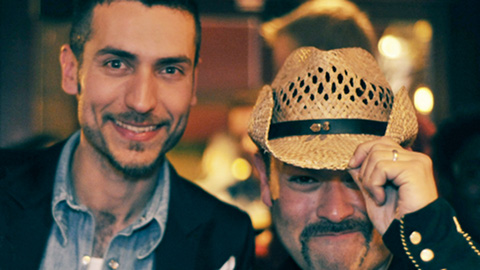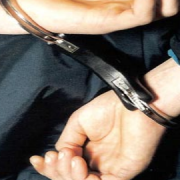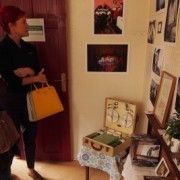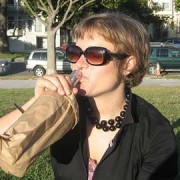Rock star families: Macca’s daughter Stella is an internationally respected fashion designer, Bowie’s son, Duncan Jones is a critically acclaimed film maker, Jagger’s daughter, Georgia May, is fast becoming a popular catwalk model. Logan Plant is a brewer in Hackney.
Son of Led Zeppellin front man Robert Plant, Logan Plant, 34, is deeply involved in the renaissance of craft brewing in the capital. Despite initially following in his fathers footsteps and fronting a band, Son’s of Albion, Logan Plant drew on another one of his father’s pastimes… drinking.
He explains: “I used to be in a band and when we first opened the bar and started serving beers, it was a a very similar feeling to being on stage, having people shouting at you, it was great.”
Proud of his West Midlands upbringing he adds: “Where I’m from there is a big, big beer culture there. My dad used to take me to many country pubs and long summer holidays were spent in and out of beer gardens. This initially put me off drinking until I was at least nineteen, but, then my palette developed and I really grew to like my local beers, it became a real obsession for me.”
Passionate about this subject, Plant now manages Duke’s Brew & Que, Downham Road, Hackney. Offering a unique selection of ales brewed to work with the American inspired menu of chargrilled pork, lamb and beef, Plant says: “We like to challenge peoples taste buds, by producing beer and food that compliment each other.”
To keep up with the growing demand, Duke’s Brew & Que are moving from their pubs cramped kitchen to a warehouse in Hackney Wick. Plant is enthusiastic about the move saying, “It will allow us to brew everyday, five days a week, keeping up the demand of the core range and experimenting with new brews.”
The craft beer movement is part of a bigger picture. The young people of Hackney have long been fighting back against the chain stores: from the surge of local coffee shops to the independent record stores and community run restaurants, there is an environment that favours quality over quantity and experimental possibilities over reliable branding.
Now, as John Swain of Hackney Brewery points out: “Drink is the next thing to take off, people want to know what goes into it, so you now have organic wines and craft beer. Not a lot goes into craft beer you have the grain, hops, water and natural yeast, it is pretty much chemical free.”
In the last 12 months Hackney has gone from having no craft breweries to having five, and this number is set to increase. With more people in the 18-25 demographic drinking ale over lager, Hackney has become the hub of ale production in London. With each brewery offering their own unique ale experience from the Duke and Brew’s Americano vibe to the Crate Brewery pizzeria, the breweries have founded a new sense of community that continues to thrive.
London, now has more active real ale breweries than any time since the 1930’s. The once ‘old man drink’, often associated with CAMRA, an independent ‘Campaign for Real Ale’ that was launched in 1971, has now fallen on a new generation, hungry to push the boundaries.
Plant says that this is something to be celebrated: “It is all about the community, people get attracted to it, they like to get into the brand and the brewery, picking up on it and standing behind it.”
Co-worker, James Rylance adds, “Our battle is not against the other brewers it is against the giant producers and the huge conglomerates. The high quality we and everyone else produces, reflects well on all of us, meaning that more people are getting into it.”
Plant explains: “It’s about how you define yourself as a generation, our parent’s generation were ale drinkers in the 50s and 60s and then in the 70s you couldn’t be seen as a trendy guy if you were not drinking lager, this was largely to do with advertising campaigns from brands such as Heineken.”
After the success of Hackney’s Pigs Ear Beer Festival, sponsored by CAMRA last September and plans for further breweries to be put into place, it is fair to say that the ale drinking drinking trend continues to support Hackney’s on going mission to save the independent market.
Despite lager being the number one alcoholic drink of choice in the UK earning £11.4billion, in 2011 ale saw a 1.6% increase selling 2.2million barrels.
Adrian Redfern, bar manager of Crate Brewery, a place where new advertising and marketing have caused sales to increase and attract a younger consumer said: “Young people are media, internet and blog savvy. So, you have to have a good website and be on Facebook or Twitter. Generally the breweries which have a strong online presence are the ones that are attracting the younger customers.”
With each brewery producing three or more unique ales each, Rylance emphasises how variety and quality gives the customers great satisfaction, “People expect the beer we produce to challenge them, giving them something to talk about, an overall experience as opposed to a product that will just make you talk more.”
This demand is what makes the surge in ale breweries more than just a retro fling or a passing fashion phase. Much like the popularity of the local independent food stores and coffee shops, ale drinking is pushing it’s way into the mainstream.
It’s not just happening in Hackney though, CAMRA supports over 200 ale pubs all over the UK. Plant explains: “It’s slowly turning, I mean you have some of the best producers in Huddesfield, Yorkshire, Sheffield, these are the brewing capitals. most breweries are within that region, but, they are popping up all over the place and they are in huge demand.”
Redfern says, “The thing with craft beer and it’s gaining popularity is that good quality should be mainstream. We want to be mainstream, and we want mainstream to be good.”





